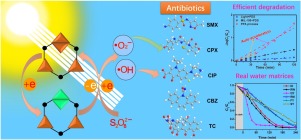当前位置:
X-MOL 学术
›
J. Hazard. Mater.
›
论文详情
Our official English website, www.x-mol.net, welcomes your feedback! (Note: you will need to create a separate account there.)
In situ photoreduction of structural Fe(III) in a metal-organic framework for peroxydisulfate activation and efficient removal of antibiotics in real wastewater.
Journal of Hazardous Materials ( IF 13.6 ) Pub Date : 2020-01-11 , DOI: 10.1016/j.jhazmat.2019.121996 Renli Yin 1 , Yanxi Chen 1 , Shaoxiong He 1 , Wanbin Li 1 , Lixi Zeng 1 , Wanqian Guo 2 , Mingshan Zhu 1
Journal of Hazardous Materials ( IF 13.6 ) Pub Date : 2020-01-11 , DOI: 10.1016/j.jhazmat.2019.121996 Renli Yin 1 , Yanxi Chen 1 , Shaoxiong He 1 , Wanbin Li 1 , Lixi Zeng 1 , Wanqian Guo 2 , Mingshan Zhu 1
Affiliation

|
Structural Fe(III) is widely found in various coordination complexes and inorganic compounds. In this work, a typical Fe-based metal organic framework (MOF) (viz. MIL-100(Fe)) was chosen as an example in the activation of peroxydisulfate (PDS) for the removal of antibiotic pollutants. Interestingly, an auto-acceleration effect was observed in the process of MIL-100(Fe) activating PDS aided by visible light irradiation. Compared to the processes with MIL-100(Fe)-activated PDS alone and the photo-activated PDS alone, the degradation efficiency of sulfamethoxazole (SMX) obtained in the visible light assisted PDS activation by MIL-100(Fe) process was enhanced by 2.1 and 5.6 times, respectively. Therein, the photogenerated electrons from MIL-100(Fe) carried out an in situ reduction of the surface structural Fe(III) to form Fe(II), which in turn significantly improved the PDS activation efficiency in the generation of ·OH and O2-· radicals for the removal of SMX. The degradation pathways of SMX were deduced based on the experimental results and theoretical calculations. Acute toxicity estimation indicated the formation of less toxic products after the treatment of SMX. Additionally, degradation of five antibiotics in the real wastewater were investigated to further confirm the advantages of such in situ photoreduced structural Fe(III) in MOFs to activate the PDS process.
中文翻译:

原位光还原结构中的Fe(III)在有机金属框架中过氧化二硫酸盐活化并有效去除实际废水中的抗生素。
结构Fe(III)广泛存在于各种配位化合物和无机化合物中。在这项工作中,选择了典型的铁基金属有机骨架(MOF)(即MIL-100(Fe))作为过氧二硫酸盐(PDS)活化以去除抗生素污染物的示例。有趣的是,在MIL-100(Fe)活化可见光照射下的PDS的过程中观察到了自动加速作用。与单独使用MIL-100(Fe)活化的PDS和单独使用光活化的PDS的过程相比,通过MIL-100(Fe)的过程在可见光辅助PDS活化中获得的磺胺甲恶唑(SMX)的降解效率得到了提高。分别是2.1和5.6倍。其中,来自MIL-100(Fe)的光生电子对表面结构Fe(III)进行原位还原以形成Fe(II),这反过来显着提高了生成SOH的·OH和O2-·自由基时PDS的活化效率。根据实验结果和理论计算推导了SMX的降解途径。急性毒性估计表明,SMX处理后形成了毒性较小的产品。此外,对真实废水中的五种抗生素的降解进行了研究,以进一步证实MOF中原位光还原的结构Fe(III)的优点,以激活PDS过程。急性毒性估计表明,SMX处理后形成了毒性较小的产品。此外,对真实废水中的五种抗生素的降解进行了研究,以进一步证实MOF中原位光还原的结构Fe(III)的优点,以激活PDS过程。急性毒性估计表明,SMX处理后形成了毒性较小的产品。此外,对真实废水中的五种抗生素的降解进行了研究,以进一步证实MOF中原位光还原的结构Fe(III)的优点,以激活PDS过程。
更新日期:2020-01-13
中文翻译:

原位光还原结构中的Fe(III)在有机金属框架中过氧化二硫酸盐活化并有效去除实际废水中的抗生素。
结构Fe(III)广泛存在于各种配位化合物和无机化合物中。在这项工作中,选择了典型的铁基金属有机骨架(MOF)(即MIL-100(Fe))作为过氧二硫酸盐(PDS)活化以去除抗生素污染物的示例。有趣的是,在MIL-100(Fe)活化可见光照射下的PDS的过程中观察到了自动加速作用。与单独使用MIL-100(Fe)活化的PDS和单独使用光活化的PDS的过程相比,通过MIL-100(Fe)的过程在可见光辅助PDS活化中获得的磺胺甲恶唑(SMX)的降解效率得到了提高。分别是2.1和5.6倍。其中,来自MIL-100(Fe)的光生电子对表面结构Fe(III)进行原位还原以形成Fe(II),这反过来显着提高了生成SOH的·OH和O2-·自由基时PDS的活化效率。根据实验结果和理论计算推导了SMX的降解途径。急性毒性估计表明,SMX处理后形成了毒性较小的产品。此外,对真实废水中的五种抗生素的降解进行了研究,以进一步证实MOF中原位光还原的结构Fe(III)的优点,以激活PDS过程。急性毒性估计表明,SMX处理后形成了毒性较小的产品。此外,对真实废水中的五种抗生素的降解进行了研究,以进一步证实MOF中原位光还原的结构Fe(III)的优点,以激活PDS过程。急性毒性估计表明,SMX处理后形成了毒性较小的产品。此外,对真实废水中的五种抗生素的降解进行了研究,以进一步证实MOF中原位光还原的结构Fe(III)的优点,以激活PDS过程。



























 京公网安备 11010802027423号
京公网安备 11010802027423号